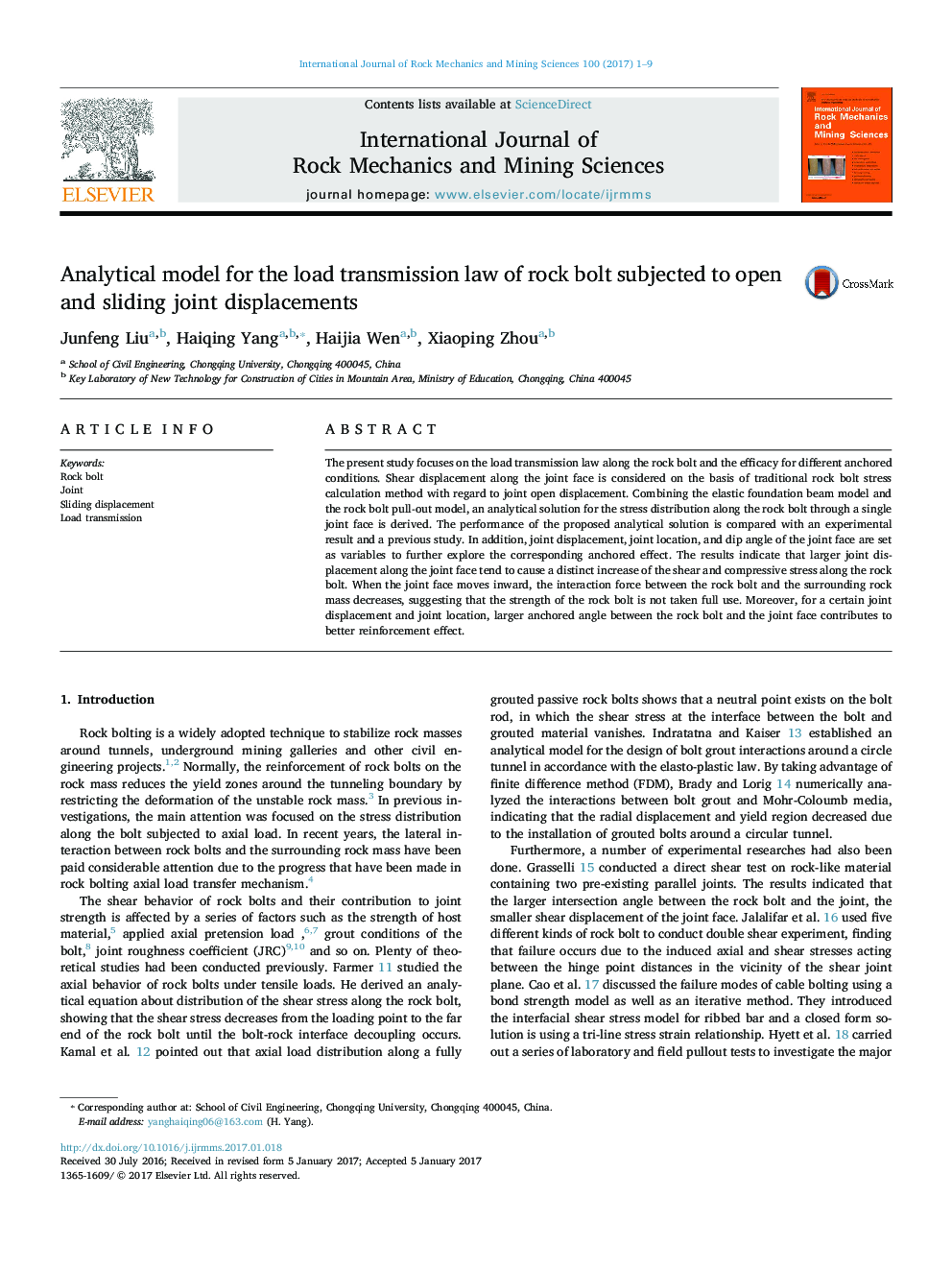| کد مقاله | کد نشریه | سال انتشار | مقاله انگلیسی | نسخه تمام متن |
|---|---|---|---|---|
| 7206401 | 1468669 | 2017 | 9 صفحه PDF | دانلود رایگان |
عنوان انگلیسی مقاله ISI
Analytical model for the load transmission law of rock bolt subjected to open and sliding joint displacements
ترجمه فارسی عنوان
مدل تحلیلی برای قانون انتقال بار سنگی تحت جابجایی های باز و کشویی
دانلود مقاله + سفارش ترجمه
دانلود مقاله ISI انگلیسی
رایگان برای ایرانیان
کلمات کلیدی
پیچ پیچ مشترک جابجایی کشویی، انتقال بار،
ترجمه چکیده
این مطالعه بر قانون انتقال بار در امتداد سنگ گچ و کارایی برای شرایط مختلف لنگر تمرکز دارد. جابجایی برش در امتداد صورت مشترک بر اساس روش محاسبه استرس سنگی با توجه به جابجایی مجدد باز است. با ترکیب مدل پرتوهای پایه الاستیک و مدل کشش پیچ سنگ، یک راه حل تحلیلی برای توزیع استرس در امتداد سنگی پیچ از طریق یک چهره مشترک، مشتق می شود. عملکرد راه حل تحلیلی پیشنهاد شده با یک نتیجه تجربی و یک مطالعه قبلی مقایسه شده است. علاوه بر این، جابجایی جابجایی، محل اتصال و زاویه شیب چهره مشترک به عنوان متغیرهایی برای بررسی بیشتر اثرات متناظر آن تنظیم شده است. نتایج نشان می دهد که جابجایی جابجایی بزرگ در طول صورت مشترک باعث افزایش شدید تنش برشی و فشاری در طول سنگ می شود. هنگامی که چهره مشترک به سمت داخل حرکت می کند، نیروی متقابل بین پیچ سنگ و سنگ توده های اطراف آن کاهش می یابد، و این نشان می دهد که قدرت پیچ و خم سنگ کاملا استفاده نشده است. علاوه بر این، برای جابجایی مشخصی و محل مشترک، زاویه لنگر بزرگتر بین پیچ و مهره سنگی و چسب مشترک به بهبود تقویت بیشتر کمک می کند.
موضوعات مرتبط
مهندسی و علوم پایه
علوم زمین و سیارات
مهندسی ژئوتکنیک و زمین شناسی مهندسی
چکیده انگلیسی
The present study focuses on the load transmission law along the rock bolt and the efficacy for different anchored conditions. Shear displacement along the joint face is considered on the basis of traditional rock bolt stress calculation method with regard to joint open displacement. Combining the elastic foundation beam model and the rock bolt pull-out model, an analytical solution for the stress distribution along the rock bolt through a single joint face is derived. The performance of the proposed analytical solution is compared with an experimental result and a previous study. In addition, joint displacement, joint location, and dip angle of the joint face are set as variables to further explore the corresponding anchored effect. The results indicate that larger joint displacement along the joint face tend to cause a distinct increase of the shear and compressive stress along the rock bolt. When the joint face moves inward, the interaction force between the rock bolt and the surrounding rock mass decreases, suggesting that the strength of the rock bolt is not taken full use. Moreover, for a certain joint displacement and joint location, larger anchored angle between the rock bolt and the joint face contributes to better reinforcement effect.
ناشر
Database: Elsevier - ScienceDirect (ساینس دایرکت)
Journal: International Journal of Rock Mechanics and Mining Sciences - Volume 100, December 2017, Pages 1-9
Journal: International Journal of Rock Mechanics and Mining Sciences - Volume 100, December 2017, Pages 1-9
نویسندگان
Junfeng Liu, Haiqing Yang, Haijia Wen, Xiaoping Zhou,
